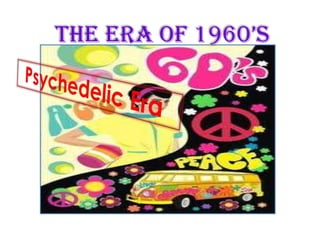
The era of 1960’s
- 1. THE ERA OF 1960’s Psychedelic Era
- 2. An Overview of the sixties A complex turn of events Cultural and political trends across the globe Fall of Racism Africa gained Independence from its colonial rulers Cold War – Vietnam War (1945-1991) (1955-1975) 1961- John F Kennedy was the new elected President of US 1968- Richard Nixon was the Elected President
- 3. The Cultural Revolution Cultural Revolution (1969-1970) Young People began to revolt against the conservative norms of the society. Social Revolution sparked in US as a reaction against US Government as the government had extensive military intervention in Vietnam War.
- 4. Vietnam War (1959-1975) Ho Chi Minh – Communist leader of North Vietnam until his death in 1969. Vietnam, Laos and Cambodia in Asia were a part of the French empire in South –East Asia. These countries fought for their Independence from the French. – (First Phase) In 1961- the Civil War began in South Vietnam and US intervened to prevent the spread of Communism, but failed. (Second Phase)
- 5. The Vietnam War The Vietnam War resulted in 58,500 death of Americans. Anti – War Movements started in protest in the US. Students from various Universities sparked the protests and a mass movement was developed.
- 6. Why did USA involved itself? In public, the Americans said their intervention was to protect the independence of the Vietnamese people, but the real reason was to keep the country secure from the communist nations.
- 8. The Cuban Revolution Convinced that Cuba was a Communist State, the then President John F Kennedy, approved a plan to invade Cuba from American Bases. The American Secret Service (CIA) was deeply involved. The situation was tensed and the world was on the verge of a Nuclear War.
- 9. CheGuvera
- 10. 10 Three norms aimed at youth and their Reaction 1. obey authority 2. control your emotions 3. fit in with the group These messages reveal the desire for normalcy and security in a post-Depression, post-war conservative culture. In the 60s, all three norms would be rejected by the youth counterculture. Questioning the Authority. Demanding for Freedomand Rights Civil Rights Movements for Women and African Americans
- 11. 11 Consumerism The new consumerism focused on recreation and the new expectation that life should be fun (hedonism), as promoted in corporate TV ads. Families were encouraged to take vacations. There were new sources of hedonistic pleasures, like Disneyland. The station wagon was the family car - the vacation car. The rise in motels and food chains like McDonalds catered to this new car culture. These new, high expectations influenced youth . Advertising promoted new values and lifestyles. Television became advertising’s new, powerful tool of persuasion.
- 12. Rising affluence and consumerism. Teens began to get an allowance and became consumers, allowing them to forge their own consumer styles. Suburbs allowed larger families centered around the children. Teens developed high expectations about life and pleasure
- 13. Hispanic America Hispanic: A word related to Spanish Invaders. Hispanic America includes Mexico and South American countries which are Spanish speaking countries These countries also fought to end Racism.
- 14. 14 Rise of youth culture Teen Values. Teens forged their own subculture, complete with its own distinguishing values: hedonism, irreverence (lack of respect)(to authority), freedom, rejection of rationality. Rock’n’roll emerged as the voice of teen culture. Chuck Berry is one of the founders of rock n’ roll.
- 15. 15 Rock n’ Roll of the 50’s Helped galvanize youth culture into their own differentiated identity apart from adult authority. Rejection of old (parental norms and values). Fed the growing generation gap. Crossed the race barrier, bringing changes. Emphasis on physical sensation, pleasure, soul, expressive behavior (loosen up and be free). Little Richard, Chuck Berry, and ELVIS (the white version of black soul). Elvis Presley galvanized the emerging youth culture of the mid-1950s around the values of rock n’ roll, and because of white parents were a bit more accepting. With Elvis, rock took off among mainstream teens.
- 16. Youth called themselves “HIPPIES”
- 17. Hippies use music to express themselves emotionally, spiritually, and politically. Music can make a statement, give voice to a movement, even unite us. As hippies explore their inner world, music guides them along in their quest for meaning. Without drugs it can get you high. With drugs, well, let's just say, music can be a religious experience.
- 18. The Beatles When the Beatles came to America in 1964 it really was an invasion of new music, style and attitude. They not only turned the music world upside down with their electric guitars, their happy harmonies, long hair and mod fashions, but suddenly music was fun like it hadn't been since Elvis. We boomers couldn't get enough of them, as Beatlemania swept the country.
- 19. The Beatles got serious about their music and the messages it conveyed. After all they are the biggest band ever and their influence was worldwide.
- 20. Credit John Lennon with much of the creative new work and deeper messages. George Harrison took the Beatles on a turn to the East with Ravi Shankar inspired sitar work and philosophical lyrics. Paul McCartney added a much-needed light cheery touch to their music. There's no way we can measure the profound impact of the Beatles on other artists and the course of human history. There is no a single hippy who didn't love them.